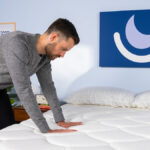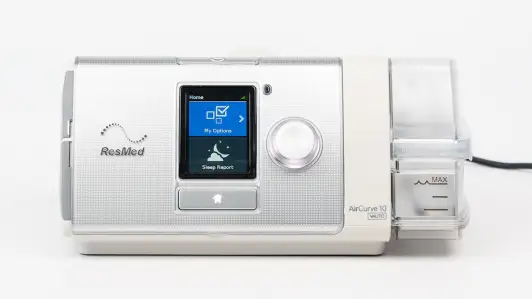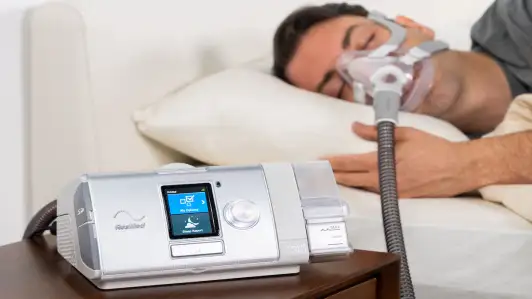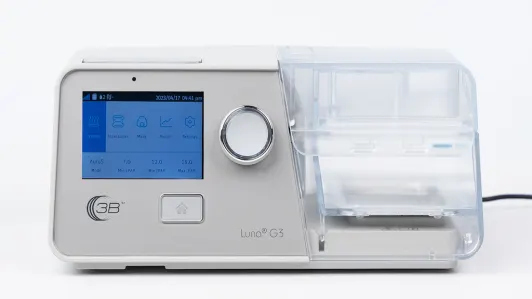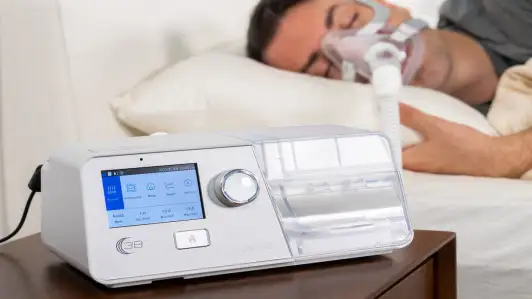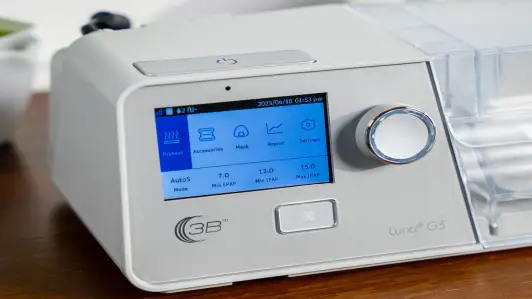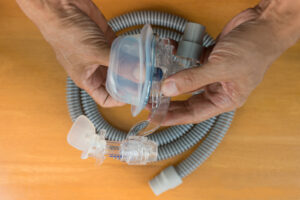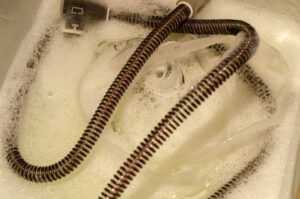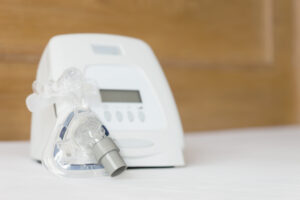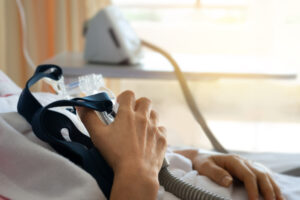Medical Disclaimer: The following content should not be used as medical advice or as a recommendation for any specific PAP product. It is important to consult your health care provider prior to starting PAP therapy or altering your current treatment for sleep-related breathing conditions.
Positive airway pressure (PAP) therapy uses pressurized air delivered through a hose and a mask to promote more consistent breathing during sleep. While continuous positive airway pressure (CPAP) devices are more frequently used to treat obstructive sleep apnea, for some people a bilevel positive airway pressure (BiPAP or BPAP) machine can provide unique benefits.
While CPAP machines operate at one fixed air pressure level, BiPAP devices feature a higher pressure setting for inhalation and lower pressure when exhaling.
We’ll provide our picks for the best BiPAP machines, discuss who may be a good candidate for a bilevel device, and share key background information that can help you choose the optimal therapy device for your needs.
The Best BiPAP Machines
Sleep Doctor’s Picks
Best Overall BiPAP Machine
ResMed AirCurve 10 VAuto BiPAP Machine
The AirCurve 10 is ideal for people who want advanced and automated features, also need supplemental oxygen during sleep, and who frequently travel with a BiPAP device.
SHOP NOW$1,995
10″ x 5.9″ x 4.6″
2.75 lbs.
27 dBA
Pros
- Compact, lightweight design
- Built-in humidifier and optional heated tubing
- Multiple therapy modes with advanced algorithms
Cons
- Extensive feature list can have a bit of a learning curve
- Heated tubing is sold separately
The ResMed AirCurve 10 VAuto BiPAP Machine is a compact device that offers compelling features at a competitive price-point. This device has a ramp setting, allowing for a slow increase in pressure as you drift off to sleep. It is equipped with a built-in humidifier and optional heated tubing to prevent condensation. It is also compatible with supplemental oxygen.
The AirCurve 10 VAuto has a number of advanced features, including multiple BiPAP modes that use sophisticated algorithms to detect and respond to breathing changes. It also includes a central sleep apnea detection feature and ResMed’s Easy-Breathe waveform with expiratory pressure relief, which mimics the user’s natural breathing pattern.
This BiPAP machine can detect and record data about a wide range of respiratory disruptions. However, unlike machines that include a cellular modem for wireless data transmission, the current iteration of the AirCurve 10 includes a removable SD card.
The ResMed AirCurve 10 VAuto comes with a two-year limited warranty. It includes a carrying case and can be powered with an auxiliary battery for taking the machine on the go.
Best Features in a BiPAP Machine
Luna G3 BPAP 25A Machine
Thanks to its low decibel level and built-in humidifier, the Luna G3 BPAP 25A is ideal for light sleepers or anyone sharing a bed with a sleep partner, people who live in a dry climate, and those who want simple and convenient data sharing with their doctor.
SHOP NOW$2,049
10.4″ x 5.7″ x 4.5″
3.75 lbs.
26 dBA
Pros
- Built-in humidifier with preheat function and heated tubing
- Quiet operation
- Cellular mode wirelessly and automatically transmits therapy data
Cons
- Not ideal for very hot or humid climates
- No leak compensation
The Luna G3 BPAP 25A Machine is one of the most feature-packed BiPAP machines on the market. This device weighs just under 4 pounds and has a small footprint that fits on most nightstands.
The G3 BPAP 25A comes with a built-in humidifier to add moisture to the flow of air and help fend off dry mouth during the night. The machine also features integrated heated tubing to prevent condensation from forming in the hose and mask, and a preheat setting warms the humidifier water before use.
A useful ramp feature starts you off with gentler pressure that gradually increases as you fall asleep. It is also one of the quieter BiPAP machines available, which makes it appealing to people who share a bed.
The machine is protected by a two-year limited warranty from the manufacturer. In addition to heated tubing, it comes with a power supply and power cord, a filter, and a travel case.
Best Value BiPAP Machine
Resvent iBreeze 30STA Auto BiPAP Machine
The Resvent iBreeze 30STA is ideal for shoppers on a budget, and anyone looking for a BiPAP with higher pressure settings in a compact design.
SHOP NOW$1,025
9.4″ x 7″ x 5″
< 3.5 lbs.
28 dBA
Pros
- Highly competitive price for a BiPAP machine
- Mask included with purchase
- Higher maximum pressure than many BiPAP models
Cons
- No cloud connection for uploading data
- Touch screen can be sensitive
The Resvent iBreeze 30STA Auto BiPAP Machine represents an excellent value for an advanced BiPAP device. This machine is below the average cost of most BiPAP machines on the market, but it’s equipped with many sophisticated features and comes with a full-face mask. Alternatively, shoppers can choose to omit the mask for a small discount.
This device includes a built-in heated humidifier and a ramp function that lets users ease into their prescribed therapy pressures. It also features multiple BiPAP operating modes, including spontaneous and spontaneous-timed modes and two auto-adjusting modes.
The Resvent iBreeze 30STA has the ability to run at a higher pressure than most BiPAP machines, reaching up to 30 cm H2O. The machine also records therapy data to an SD card that’s compatible with PC software.
The sleek touch-screen design and auto start and stop functions make the iBreeze 30STA easy and straightforward to use. It has a relatively small footprint and weighs less than 3.5 pounds. The device is backed by a two-year manufacturer’s warranty.
How We Make Our Picks
Our picks are designed to help you by simplifying the process of finding a BiPAP machine, which can often feel technical and confusing. Our team of sleep health experts has a deep understanding of sleep apnea, how PAP therapy works, and what features can contribute to successful PAP-based treatment. When choosing the best BiPAP machines, we analyzed factors like brand reputation, device features and track record, customer reviews, and product availability.
What is a BiPAP Machine?
A BiPAP machine is a medical device that sends pressurized air into the upper airway through a hose and a mask in order to stabilize breathing and treat sleep apnea and other sleep-related breathing disorders. A defining feature of a BiPAP device is its ability to deliver different levels of air pressure when inhaling and exhaling.
Most BiPAP machines come with tubing, a power supply and power cord, and an air filter. Some BiPAP devices include a built-in humidifier with a removable water chamber, though humidifiers are also available individually.
Masks are typically sold separately. Products marketed as CPAP masks are generally compatible with other types of PAP machines.
Using BiPAP Therapy for Sleep Apnea
Sleep apnea is a condition that causes brief interruptions to breathing as a person sleeps. People with sleep apnea often experience poor sleep and may have other health complications linked to repeated breathing disruptions.
To use a BiPAP machine, you wear a mask that is attached to the device by a hose. Pressurized air is sent through the tubing and into your upper airway, which helps prevent breathing interruptions during sleep. The main feature that distinguishes a BiPAP machine from other types of PAP machines is that it has separate pressure settings for when you breathe in and breathe out.
BiPAP therapy may be recommended to treat different types of sleep apnea, including obstructive sleep apnea, central sleep apnea, and complex sleep apnea.
- Obstructive sleep apnea (OSA): Obstructive sleep apnea occurs when the airway becomes temporarily blocked during sleep. The stream of air from a PAP machine can help prevent the airway from becoming obstructed. Some people find PAP therapy to be more comfortable with the variable pressure of a BiPAP device.
- Central sleep apnea (CSA): Central sleep apnea occurs when the brain’s process of controlling breathing becomes disrupted. For some people with CSA, a BiPAP machine can support a more stable and consistent breathing pattern. Some people with CSA experience Cheyne-Stokes respirations, a condition characterized by an alternating pattern of shallow breathing and hyperventilation.
- Complex sleep apnea: Referred to as treatment-emergent central sleep apnea by medical experts, this is a type of CSA that can arise in people with OSA undergoing PAP therapy. A BiPAP device that includes a backup respiratory rate ensuring a minimum number of breaths per minute may be helpful in treating this type of sleep apnea.
While BiPAP therapy is a potential treatment option for these types of sleep apnea, it is often not the first type of therapy that is recommended. In many cases, a BiPAP machine is only prescribed after CPAP therapy has already been tried.
Types of BiPAP Machines for Sleep Apnea
While the common denominator of all BiPAP machines is the delivery of different air pressure levels for inhalation and exhalation, some models include algorithms that detect breathing patterns and make various adjustments in real time.
- Fixed-pressure BiPAP: This type of BiPAP machine has fixed air pressure levels for when you breathe in and breathe out. These settings are determined during an overnight titration study where sleep technologists directly observe how well the machine is helping your breathing and adjust its settings accordingly.
- Auto-adjusting BiPAP: Some BiPAP devices are auto-adjusting, which means they use specially designed software to recognize breathing patterns and adjust the pressure levels in response. The initial settings for an auto-adjusting BiPAP machine are generally still determined during a lab-based titration study.
Are There Travel BiPAP Machines?
While travel CPAP machines are common, there are fewer travel BiPAP machine options available. However, several manufacturers offer compact, lightweight BiPAP models that are better suited to being stowed away, taken on the road, and powered with an external battery.
What is the Difference Between BiPAP and CPAP Machines?
The main difference between BiPAP and CPAP machines is that CPAP machines have one pressure setting while BiPAP devices have a higher pressure setting for breathing in and a lower pressure level for breathing out.
BiPAP and CPAP machines are fairly similar in appearance, but their differing pressure settings can have significant impacts for treating sleep apnea and other breathing-related conditions. Make sure to discuss your symptoms and unique needs with your health care provider to determine the treatment that’s best for you.
| CPAP | BiPAP |
|---|---|
Ideal for:
| Ideal for:
|
May not work for:
| May not work for:
|
How to Find the Best BiPAP Machine for You
To find the best BiPAP machine for you, it’s important to consider your priorities and needs for sleep apnea treatment. Before buying a new machine, think about your price range, how much space you have available, and what advanced features are most important to you.
BiPAP Machine Pricing and Sizing
BiPAP machines can vary widely in price, usually costing between $1,700 and $3,000. More expensive models typically offer more complex features. In general, BiPAP machines cost more than CPAP machines because they have a more diverse range of functions and pressure settings.
Most BiPAP machines are rectangular and measure less than a foot long. Although they are larger than a standard alarm clock, BiPAP machines are normally small enough to fit on a nightstand or bedside table.
BiPAP Machine Pressure Ranges and Noise Levels
| Pressure Ranges | Most BiPAP machines can provide pressure levels from 4 to 25 centimeters of water pressure (cm H2O), which is a common measure of air pressure for PAP devices. Some BiPAP devices max out at 30 cm H2O. |
| Sound Levels | Modern BiPAP machines are relatively quiet when running. The quietest machines generate only 25 to 30 decibels, a sound level equivalent to a whisper. |
BiPAP Data Tracking, Ramp Settings, and Smart Features
| Data Tracking | Many BiPAP machines can track and store key data, including how long you use your machine, sleep duration, pressure statistics, quality of mask seal, and sleep apnea events per hour. |
| Ramp Settings | A ramp setting starts the machine at a lower pressure and slowly increases the pressure level over a set period. Reduced pressure at the start of the night may make it easier to fall asleep. |
| Smart Features | Smart features include cellular connectivity, preheat settings for humidifiers, auto-adjusting screen brightness, and automatic start and stop sensors that detect when the user’s mask is in place. |
BiPAP Programmable Modes
While the ability to switch between higher and lower pressure settings for inhalation and exhalation is standard for BiPAP machines, some devices include more advanced algorithms designed to meet specific breathing needs.
- Spontaneous mode (S): In this mode, the BiPAP machine only uses the cues from a person’s breathing, such as changes in airflow, to adjust between the different pressure levels.
- Timed mode (T): In timed mode, the BiPAP machine uses a fixed time period to cycle between the pressure level for breathing in and out. Unless a person struggles to breathe on their own, it is rare for timed mode to be used because it can create misalignment between the device’s airflow and a person’s actual breathing pattern.
- Spontaneous-timed mode (S/T): In this hybrid mode, the BiPAP machine uses cues from a person’s breathing to adjust the pressure, but there’s a fail-safe — often called a backup rate or backup breath — that increases the air pressure if the machine doesn’t detect that the user has inhaled within a set period of time. This mode is often used for people with irregular breathing patterns linked to central sleep apnea.
BiPAP Prescription, Insurance, and Purchasing Information
BiPAP machines are a form of medical equipment. This means there are some rules and regulations to navigate during the purchasing process.
Do You Need a Prescription for a BiPAP Machine?
The Food and Drug Administration classifies PAP machines, including BiPAP devices, as class II medical devices. While this designation ensures that BiPAP machines meet certain safety standards, it also means that a prescription is required.
Does Health Insurance Cover BiPAP Costs?
Health insurance coverage for BiPAP expenses can be less straightforward than CPAP therapy. Some providers may only cover a portion of BiPAP costs if a person’s apnea-hypopnea index (AHI) score — a measure of sleep apnea severity — exceeds a certain threshold. Additionally, some plans only provide BiPAP coverage if it has been demonstrated that a person has first unsuccessfully tried CPAP therapy.
Check with your insurance provider regarding your plan’s PAP therapy specifics and coverage requirements.
Where Can You Buy a BiPAP Machine?
BiPAP machines are available from online and brick-and-mortar medical equipment providers, as well as retailers that specialize in CPAP devices and accessories. Regardless of the buying method, you’ll need to provide a copy of your prescription before making a purchase. Online retailers often accept prescriptions via fax or email.
Buying a BiPAP machine in person lets you see the equipment and pose questions to sales staff. Online stores generally have a larger selection of machines and often have lower prices. Stores that offer CPAP and BiPAP machines typically sell other therapy accessories, including masks, tubing, filters, and optional supplies like CPAP batteries.
How Do You Clean a BiPAP Machine?
Because it delivers air for you to breathe, it’s important to keep your BiPAP machine clean. This helps prevent bacterial growth and can extend the life of your BiPAP device and components.
In general, BiPAP machine accessories should be cleaned with warm water and mild soap. While the following are general cleaning guidelines, refer to user manuals for specific manufacturer’s instructions regarding cleaning methods and frequencies.
- Machine: Unplug the device and wipe down the outside with a nonabrasive cloth about once per week.
- Mask: Use mild soap and a damp cloth to gently clean your mask every day. Alternatively, specially designed CPAP wipes can be used for daily mask maintenance. Once a week, take your mask apart and wash all the components more thoroughly in warm water and a mild detergent. Allow everything to dry completely before reassembling the mask.
- Headgear: Take apart the headgear and straps from your mask and hand-wash them once a week or anytime they appear dirty.
- Tubing: Wash the hose thoroughly once a week and hang it up to fully dry.
- Humidifier water chamber: Empty the water tank every morning and wash it roughly once per week. Only fill the chamber with distilled water, as other types of water can cause mineral buildup and could lead to the growth of potentially harmful bacteria.
- Filters: Follow the manufacturer’s recommended schedule for replacing your filter. If you have a reusable filter, wash it once a week and replace it according to the manufacturer’s suggested time frame.
Avoid using abrasive cleaners like rubbing alcohol or bleach that can damage your BiPAP machine and accessories. The FDA has cautioned against using ozone gas or ultraviolet light cleaners, as the agency hasn’t cleared or approved these products, nor has it made a determination regarding their safety and efficacy.
Ask the Sleep Doctor
Have questions about sleep? Submit them here! We use your questions to help us decide topics for articles, videos, and newsletters. We try to answer as many questions as possible. You can also send us an email. Please note, we cannot provide specific medical advice, and always recommend you contact your doctor for any medical matters.
